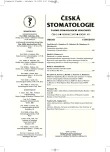Analysis of Local Factors Predisposing to Disorders in Dentition of Upper Permanent Canine Tooth
Analýza lokálních faktorů predisponujících k poruchám prořezávání horního stálého špičáku
Cíl:
Cílem prezentované studie bylo analyzovat výskyt jednotlivých lokálních faktorů uplatňujících se v etiologii poruch prořezávání horního stálého špičáku.
Materiál a metodika:
Vyšetřovaný soubor tvořilo 190 pacientů (114 žen a 76 mužů) s poruchami prořezávání horního stálého špičáku. Průměrný věk u žen byl 17,9 let a u mužů 17,4 let. U pacientů bylo analyzováno celkem 240 (140 – jednostranně a 50 – oboustranně) retinovaných nebo ektopicky prořezávajících špičáků. Jednotlivé faktory byly hodnoceny na ortopantomogramech a na CT nálezech, které byly k dispozici u všech pacientů.
Výsledky:
Byl zaznamenán výskyt lokálních etiologických faktorů – nedostatek místa (20,8 %) a úplná ztráta místa pro prořezání špičáku (10,8 %), přebytek místa (15,8 %), hypodoncie postranního řezáku (5,4 %), čípkový postranní řezák (7,5 %), transpozice špičáku s postranním řezákem (4,2 %) a s prvním premolárem (6,7 %), anomální poloha (27,9 %) a deformace tvaru kořene prvního premoláru (3,7 %), přespočetný útvar (3 %) a cysta (0,83 %) bránící prořezání špičáku, primární ektopie (1,7 %), neznámá příčina (10 %).
Závěr:
Znalost etiologie a včasná diagnostika příčinných faktorů je nezbytná pro zahájení interceptivní léčby poruch prořezávání horního stálého špičáku.
Práce je součástí projektu SVC č. 1M0528.
Klíčová slova:
horní stálý špičák – poruchy prořezávání – retence – etiologie – postranní řezák – první premolár
Authors:
P. Černochová
Authors‘ workplace:
Stomatologická klinika LF MU a FN U Sv. Anny, Brno
přednosta prof. MUDr. J. Vaněk, CSc.
Published in:
Česká stomatologie / Praktické zubní lékařství, ročník 107, 2007, 6, s. 101-106
Category:
Overview
Objective:
The aim of the present study was to analyze incidence of individual local factors participating in etiology of disorders in dentition of upper permanent canine tooth.
Material and Methods:
The examined cohort consisted of 190 patients (114 women and 76 men) with disorders in dentition of upper permanent canine tooth. The mean age of women was 17.9 years and that in men was 17.4 years. In these patients we analyzed a total of 240 (140 – unilaterally and 50 – bilaterally) retained or ectopic dentition took place. Individual factors were evaluated in orthopantomograms and CI findings which were available in all patients.
Results:
The occurrence of local etiological factors was recorded – insufficient space (20.8%) and completely lacking space for canine tooth dentition (10.8%), surplus of space (15-8%), hypodontia of lateral incisor (5.4%), uvular lateral incisor (7.5%), canine tooth transposition with lateral canine tooth(4.2%) and with the first premolar (6.7%), anomalous position (27.9%) and deformity in the root shape of the first premolar (3.7%), superfluous formation (3%) and a cyst (0.83%) preventing canine tooth dentition, primary ectopy (1.7%) and unknown cause (10%).
Conclusion:
The knowledge of etiology and early diagnosis of causal factors is necessary for initiation of interceptive therapy of disorders in dentition of upper permanent canine tooth.
The work is a part of the project SVC No.1M0528.
Key words:
upper permanent canine tooth – dentition disorders – impaction – etiology – lateral incisor – first premolar
Labels
Maxillofacial surgery Orthodontics Dental medicineArticle was published in
Czech Dental Journal

2007 Issue 6
- What Effect Can Be Expected from Limosilactobacillus reuteri in Mucositis and Peri-Implantitis?
- The Importance of Limosilactobacillus reuteri in Administration to Diabetics with Gingivitis
Most read in this issue
- Attrition, Abrasion, Corrosion and Abfraction New Overview of Superficial Teeth Lesions
- Use of Buccal Fat Pad
- Stress as Etiological Factor in Diseases of Mandibular Joint
- Cytotoxicity of Dental Alloys
